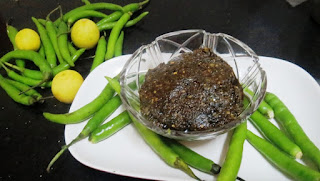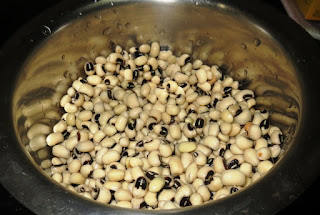Brinjal/badane kai/Kattarikai and Malabar leaves curry is a side dish and it is one of the quick and an easy dish.
Brinjal is available in the market around the year. Brinjal/Egg plant is loved by many and there are so many varieties of brinjals available in the market.
One should be careful while buying brinjal. It should not be very soft, it should not have any hole in it.Since the worms make a way inside and stay there eating all the pulp. So check before you buy the vegetable.
I have used brinjals and home grown Malabar Spinach/Basale leaves. This curry is prepared with out coconut and dal. The leaves and brinjal mixes well and when you boil the vegetables and it will be very nice.
We can have this curry with idli, dosa, plain rice or any type of roti or rotti..
Lets see some benefits of having Dry Ginger in our diet.
Ginger is one of the healthiest spice. It is loaded with nutrient components which help our body. Ginger is used in cooking and as medicine. It is good remedy for digestion and it helps in reducing nausea. (Vomiting sensation). It also helps in common cold and flu. Ginger contain good amount of anti inflammatory properties and common health problems like headache, common cold etc. It has good anti diabetic properties and good for lowering the blood sugar. It also help in losing weight, lowering the cholesterol levels. Ginger helps in reducing the menstrual pain in women. It also helps in reducing the muscle pains and used in beauty products too.
Brinjal/Egg Plant - Malabar Leaves curry has no dals or no coconut. It has no onions or garlic. We can have this curry with plain rice, idli, dosa, chapati or any kind of roti.
Lets see the recipe Now :
Brinjals/Egg Plants : 4 to 5 (small size)
Malabar leaves (or any leaves of your choice) : 1 Small bundle
Tomatoes : 2
To Add :
Sambar Powder : 2 Tablespoons
Tamarind : 2 Tablespoon pulp
Turmeric Powder : a pinch
Salt : As required
Methi/Fenugrik seeds : 1/4 Teaspoon
Coriander leaves : 2 Tablespoon
Dry ginger powder : 1/2 Teaspoon
For Seasoning :
Oil : 1 Teaspoon
Ghee : 1 Teaspoon (Optional)
Mustard seeds : 1/2 Teaspoon
Jeera : 1/2 Teaspoon
Ingh/Asafoetida : a pinch
Curry Leaves : 6 to 8
2. Wash and cut tomatoes and Malabar leaves and keep it aside.
3. Soak marble size tamarind in hot water for 5 minutes and squeeze out the pulp. Keep the pulp aside.
4. Now keep a big pan on the fire and add a glass of water. Let it boil. Add cut malabar/basale leaves.
5. Add brinjal pieces along with malabar/basale leaves. (squeeze out the water from brinjal before adding). Add methi seeds to the vegetable mixture.
6. Let it cook for 3 to 4 minutes. (Till they turn soft). Add cut tomatoes and cook for 2 minutes.
7. Add tamarind pulp, required salt and little jaggery. (optional). Add ginger powder.
8. Add sambar powder and mix it well and cook for another 2 minutes. Add coriander leaves.
9. Shift the ready curry to a serving bowl and add mustard seasoning.
10. Add a spoon of ghee and then serve with the main dish of your choice.
Sambar Powder Recipe : Dry roast methi seeds (1/4 teaspoon), Urid dal (1 teaspoon), coriander seeds (2 tablespoons), jeera (1/2 Teaspoon) and 5 to 6 red chilly (byadagi) one by one and dry grind it. (You can use 1 teaspoon of oil to fry these ingredients to get more taste). Adding ingh is optional.
Time : 20 minutes
Serves : 3 to 4
Brinjal is available in the market around the year. Brinjal/Egg plant is loved by many and there are so many varieties of brinjals available in the market.
One should be careful while buying brinjal. It should not be very soft, it should not have any hole in it.Since the worms make a way inside and stay there eating all the pulp. So check before you buy the vegetable.
I have used brinjals and home grown Malabar Spinach/Basale leaves. This curry is prepared with out coconut and dal. The leaves and brinjal mixes well and when you boil the vegetables and it will be very nice.
We can have this curry with idli, dosa, plain rice or any type of roti or rotti..
Lets see some benefits of having Dry Ginger in our diet.
Ginger is one of the healthiest spice. It is loaded with nutrient components which help our body. Ginger is used in cooking and as medicine. It is good remedy for digestion and it helps in reducing nausea. (Vomiting sensation). It also helps in common cold and flu. Ginger contain good amount of anti inflammatory properties and common health problems like headache, common cold etc. It has good anti diabetic properties and good for lowering the blood sugar. It also help in losing weight, lowering the cholesterol levels. Ginger helps in reducing the menstrual pain in women. It also helps in reducing the muscle pains and used in beauty products too.
Brinjal/Egg Plant - Malabar Leaves curry has no dals or no coconut. It has no onions or garlic. We can have this curry with plain rice, idli, dosa, chapati or any kind of roti.
Lets see the recipe Now :
Ingredients
To Cook :Brinjals/Egg Plants : 4 to 5 (small size)
Malabar leaves (or any leaves of your choice) : 1 Small bundle
Tomatoes : 2
To Add :
Sambar Powder : 2 Tablespoons
Tamarind : 2 Tablespoon pulp
Turmeric Powder : a pinch
Salt : As required
Methi/Fenugrik seeds : 1/4 Teaspoon
Coriander leaves : 2 Tablespoon
Dry ginger powder : 1/2 Teaspoon
For Seasoning :
Oil : 1 Teaspoon
Ghee : 1 Teaspoon (Optional)
Mustard seeds : 1/2 Teaspoon
Jeera : 1/2 Teaspoon
Ingh/Asafoetida : a pinch
Curry Leaves : 6 to 8
Method :
1. Wash and cut brinjals and soak them in water.2. Wash and cut tomatoes and Malabar leaves and keep it aside.
3. Soak marble size tamarind in hot water for 5 minutes and squeeze out the pulp. Keep the pulp aside.
4. Now keep a big pan on the fire and add a glass of water. Let it boil. Add cut malabar/basale leaves.
5. Add brinjal pieces along with malabar/basale leaves. (squeeze out the water from brinjal before adding). Add methi seeds to the vegetable mixture.
6. Let it cook for 3 to 4 minutes. (Till they turn soft). Add cut tomatoes and cook for 2 minutes.
7. Add tamarind pulp, required salt and little jaggery. (optional). Add ginger powder.
8. Add sambar powder and mix it well and cook for another 2 minutes. Add coriander leaves.
9. Shift the ready curry to a serving bowl and add mustard seasoning.
10. Add a spoon of ghee and then serve with the main dish of your choice.
Sambar Powder Recipe : Dry roast methi seeds (1/4 teaspoon), Urid dal (1 teaspoon), coriander seeds (2 tablespoons), jeera (1/2 Teaspoon) and 5 to 6 red chilly (byadagi) one by one and dry grind it. (You can use 1 teaspoon of oil to fry these ingredients to get more taste). Adding ingh is optional.
Note :
You can use any type of brinjal. You can use methi, palak, harive (Amaranth leaves) instead of Malabar/Basale leaves. I have used home prepared sambar (curry powder) powder. You can use any brand of sambar powder. Adding onions and garlic is also optional. Adding methi seeds along with vegetables helps to reduce the cholesterol and adds taste to the curry.Time : 20 minutes
Serves : 3 to 4

























































